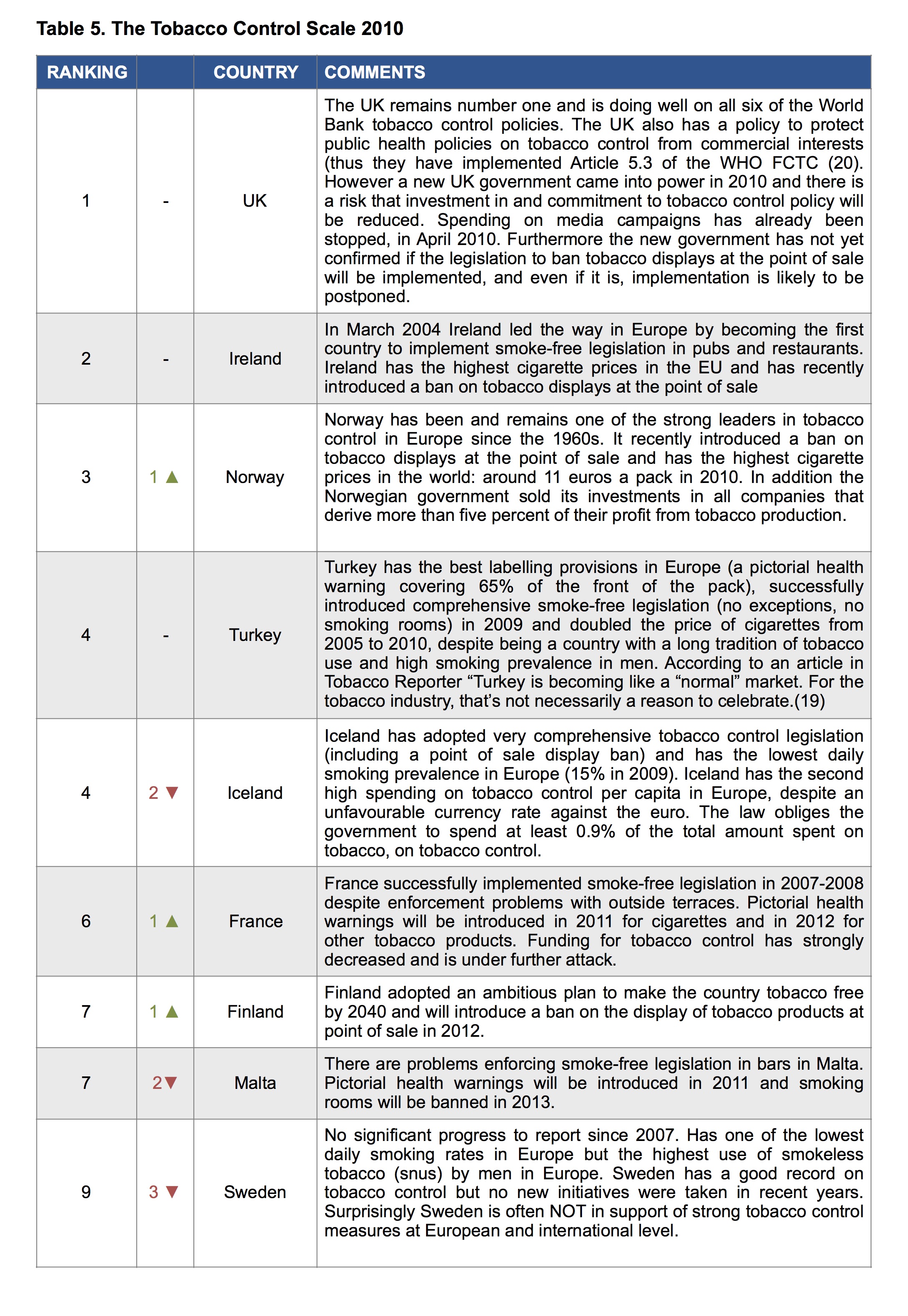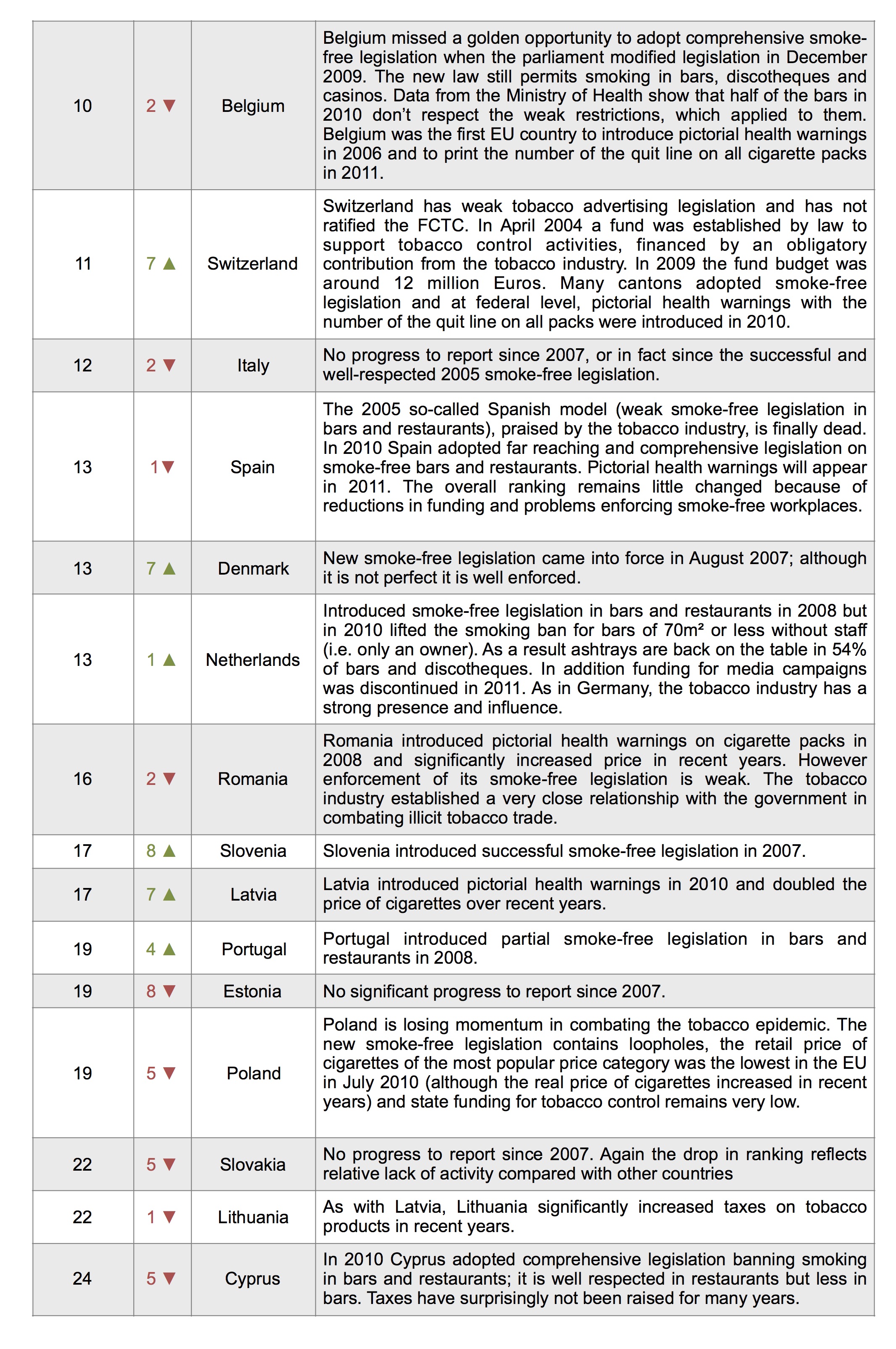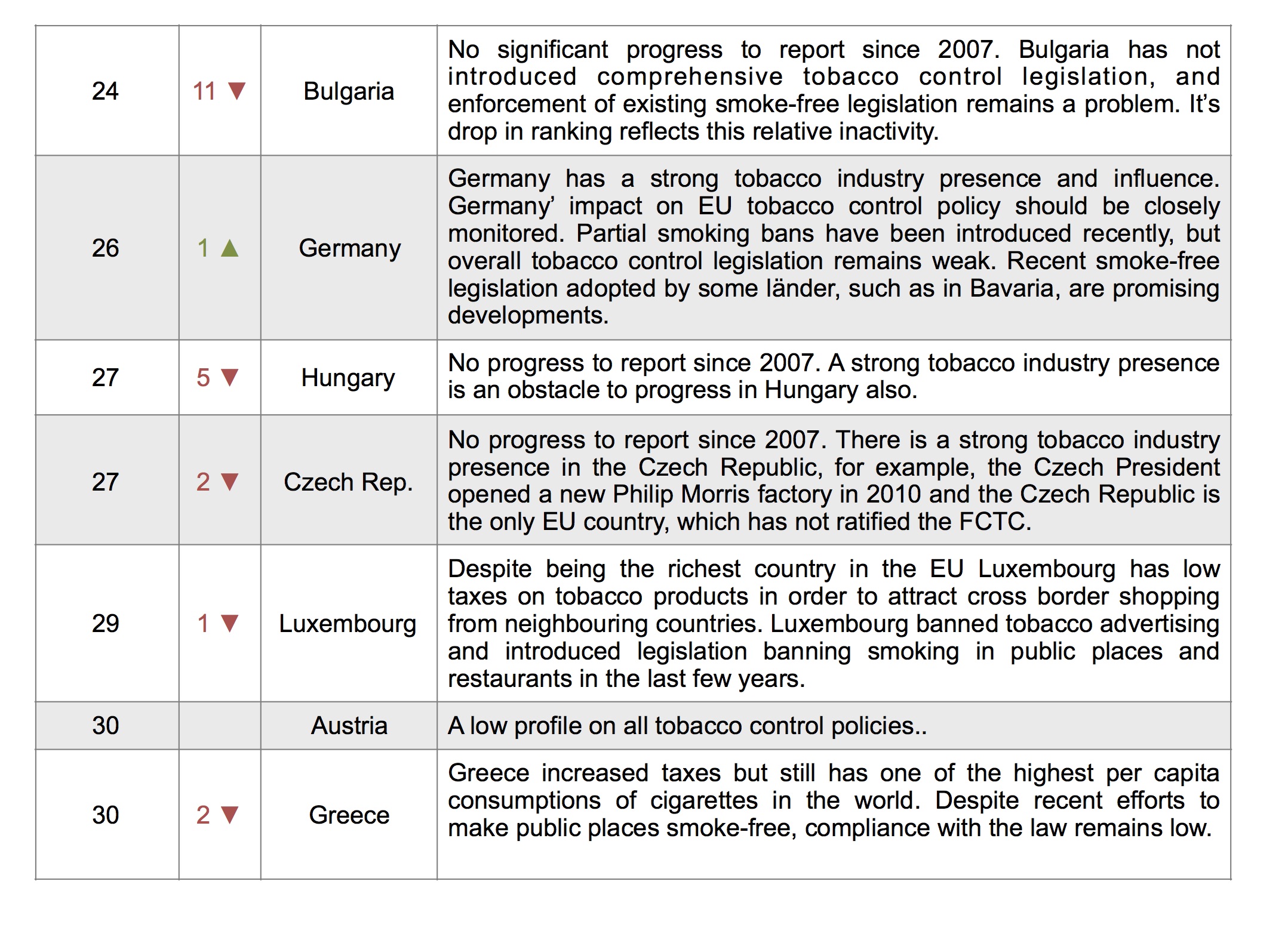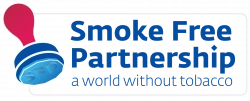COMMENTS AND KEY PROVISIONS
The Tobacco Control Scale 2010 in Europe
Discussion
Martinez-Sanchez and colleagues examined the relationship between TCS scores and smoking prevalence in the 27 EU countries and found that higher TCS scores were strongly associated with lower smoking prevalence (15). In a study in 18 European countries Schaap and colleagues found a positive association between TCS scores and age standardised quit ratios (16). Hublet and colleagues examined the associations between tobacco control policies at country level, drawn from the TCS, and smoking prevalence in 15 year old adolescents in 29 European countries. They found that policies on price, smoking in public and advertising bans may help to reduce smoking prevalence in boys, but that the associations were weaker for girls (17). Another study confirmed the relationship between second-hand smoke exposure in non-smokers, as assessed by exhaled carbon monoxide, and TCS scores in the 27 EU countries (18).
Overall countries, which failed to undertake new initiatives, lost TCS points and fell in the ranking. Countries with comprehensive policies in the six tobacco control policies are leading tobacco control in Europe.
A specific concern is the lack of funding for tobacco control. Two thirds of the countries spent less than 10 euro cent per capita on tobacco control. The TCS scores for spending on tobacco control are extremely low. We are seeing reduced funding for tobacco control in several countries and there is clearly a risk of even further reductions in the coming years. Only Switzerland, Iceland and UK secured reasonable (but not sufficient) tobacco control funding in 2009.
Price policy remains the most effective way to reduce sales. Prices in Lithuania, Romania, Bulgaria and Latvia increased strongly in recent years, but only as result of obligations under the 2002/10/EC Tobacco Tax Directive. Norway has the highest cigarette prices in Europe and probably in the world: 10 euro for a pack of Marlboro in the supermarket and 12 euro in the kiosk. Ireland has the highest prices in the EU, as the UK was affected by the unfavourable currency exchange of the British Pound towards the Euro in recent years.
Areas of improvement
According to the stock analysts Morgan Stanley “Of the various measures available to governments in reducing demand for tobacco, clearly the one that concerns the cigarette companies the most is rising taxation.” (21). High price remains the most effective tobacco control measure, thus it is important to note that the price of tobacco products varies greatly in Europe. On 1 July 2010 a pack of Marlboro cigarettes ranged from €2.55 in the Baltic countries to €8.55 in Ireland and €11 in Norway.
According to Morgan Stanley again “the other two regulatory environment changes that concern the industry the most are homogenous packaging and below-the-counter sales. Both would significantly restrict the industry’s ability to promote their products.”(21)
A ban on displaying tobacco products at the point of sale exists in three European countries (Iceland, Ireland and Norway) and will be introduced in Finland in 2012. Six European countries (Belgium, Romania, UK, Latvia, Switzerland and Turkey) require pictorial warnings on cigarette packets and four will introduce them in 2011: Malta, France, Spain and Norway. The global trend is towards larger health warnings with pictures. Uruguay, for instance, has implemented legislation to make pictorial health warnings obligatory, covering 80% of the front and the back of cigarette packs. The 2001 EU Tobacco Products Directive regulates the content and labelling of tobacco products in the EU. The European Commission is exploring the merits of introducing plain packaging as part of the revision of the Directive. Last year the Australian government decided to introduce legislation to make plain packaging mandatory on all tobacco products as of 2012.
Plain packaging includes the removal of all attractive promotional aspects on tobacco product packaging. Except for the brand name (which would be presented in a standardized way) all other trademarks, logos, colour schemes and graphics would be prohibited. The package itself would be required to be plain coloured and to display only information (such as health warnings) required by law.
A number of studies on plain packaging report the same results (22,23,24):
- Plain cigarette packs are less attractive than the current ones
- Plain cigarette packs reduce the promotional appeal of the packs
- Plain cigarette packs enhance the visibility of the health warnings.
Large (80%) picture warnings should be placed on the front and back of all tobacco products in combination with standardised/plain packaging, The pictures should be renewed on regular basis, with the aim that the whole pack would become a platform for mandatory health promotion messages.
On the basis of the research reviewed in our introduction, and our results, there are some serious shortcomings in tobacco control in Europe at the moment. There is an urgent need for more investment. In the EU only the UK spent €1 per capita per year on tobacco control. The 2004 ASPECT report recommended that EU member states immediately increase per capita spending by €1-3 (25).
No European country had banned smoking in bars and restaurants by January 2004. By January 2011 sixteen countries had introduced smoke-free bars and restaurants and more countries are planning to do so. The most comprehensive European smoke-free legislation (a complete ban on smoking at the workplace - including bars and restaurants - with no exemptions at all) has been introduced in Ireland, Scotland, England and Turkey. Genuinely comprehensive smoke-free legislation, which includes a total ban in all work places (including bars and restaurants), public places (including health and educational facilities) and public transport, should be a priority for every European country.
Comments on individual countries
Here we comment briefly on individual countries, in reverse order of their 2010 ranking (in brackets the 2007 ranking and up or down movement).






The Tobacco Control Scale is partly funded by operating funding from the European Commission to Smoke Free Partnership. The views expressed in this website do not necessarily reflect the official views of the European Union institutions.
Copyright 2022 © All Rights Reserved


